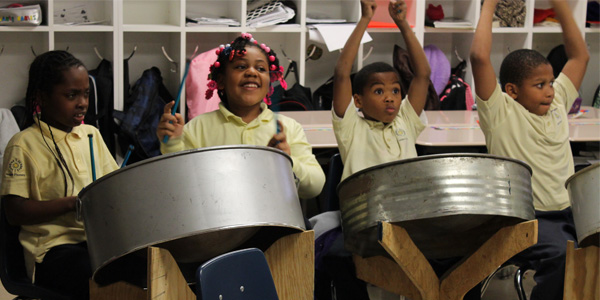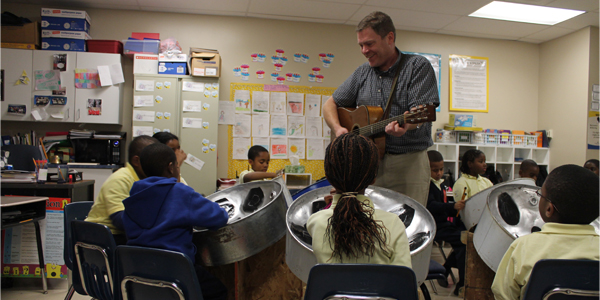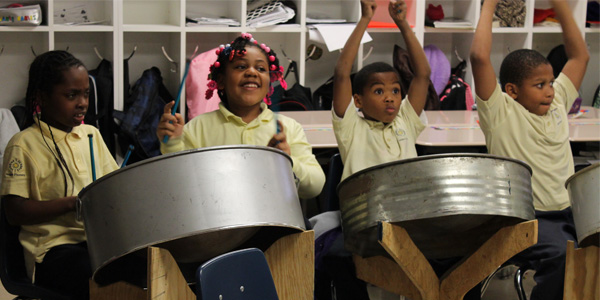Blog
Learning in action: How songwriting transformed the classroom
By Karen Baratz, Parent of a Westbrook Elementary third-grader

Even if I had not been a classroom volunteer at Westbrook Elementary this year, I would have heard about Young Audiences teaching artist Alden Phelps’ residency program from my son and his classmates who talked about the program with an enthusiasm that I don’t often hear about schoolwork.
As a parent helper in the classroom, I got to observe Alden in action. He had a remarkable way of engaging the children so that everyone wanted to participate in the songwriting process and his ability to get students to collaborate and come to a consensus on lyrics and ideas was impressive.
From the minute Alden walked into the third grade classroom, he had a captive audience. He instantly connected with the students through his songs, humor, and gentle manner. He used a creative approach to engage students in activities so that they could better understand the songwriting process and what a parody was before they began to compose a parody song of their own. Alden is a natural with children and came well-prepared with popular melodies that the kids could adapt with their own lyrics. The fact that the students got to sing their own version of current songs they hear on the radio took the children’s enthusiasm for Alden’s residency way up!
Alden was able to adapt his program to the curriculum, tying in what he does with what the students were studying in class—geographic regions of the U.S.—for a more in-depth learning experience. He had a game plan in place to help three third-grade classes quickly compose meaningful (and funny!) songs about their respective geographic regions which they were so proud to perform for the school and their parents at the end of the program.
This was an amazing opportunity to get a window into my child’s school life. So often, parents don’t get many details of what goes on during the school day but this experience provided me the opportunity to work side-by-side with the children and watch learning in action.
The bottom line is that Alden made learning fun. In our competitive society where education standards often place a greater emphasis on subjects like reading and math at the expense of the arts, I feel that our children are being shortchanged. The arts play such an important role in helping students see the whole picture and they can help make learning fun! I can think of no better example of this than the fact that my son was so excited about songwriting and parodies after Alden’s residency ended, that he wrote one of his own. He created a music video about geometric shapes to a popular tune and couldn’t wait to share it with his teachers and classmates. If that isn’t proof of the power art has to boost academic performance—I don’t know what is.
Learn more about Alden Phelps’ assembly and residency programs here!
How can the Blues be used to learn fractions?
By Curtis Blues, One-man Blues band
Young Audiences artists and teacher partners have written case studies documenting their work in schools and their exploration of one essential question. Each study provides a snapshot of how the artist or teacher works with students to integrate the arts into the curriculum and provide opportunities for students to imagine, create, and realize their full potential through the arts.
Project or Program Summary
My co-teacher and I met with Arts Integration Specialist Maria Barbosa to create a lesson plan that connected fractions to Blues music. We aimed to create a lesson that was aligned with the state math and fine arts curriculum as well as the Common Core Standards. Specifically, we wanted to address how music arises from a person’s cultural context. I immediately thought that the first Blues instrument, the single-stringed diddly bow, might serve as a great physical model for a number line fractions lesson.
The diddly bow was created by Delta blues musicians in the South before they could afford six-string guitars. It was usually put on the side of a barn door and played with a bottle, but my classroom model is a single string on a board, using the resonance of metal jar tops to project the sound. It is a piece of musical history that shows students the ingenuity of the men and women who invented Blues music.
Maria went to work to figure out how to put versions of this instrument in the students’ hands. She came up with a brilliant cardboard and rubber band version of the diddly bow that each student could play. Maria felt that the strength of the lesson was in having the students not only see and hear my instrument, but to play their own.
I started the class off with the art form, playing a Blues song on the diddly bow while the students clapped the work-song Blues rhythm with their hands. The students were fascinated with the instrument and understood how the Blues arose from the context of African Americans working on farms without access to instruments other than homemade ones like the diddly bow.
My co-teacher reviewed the material about fractions and number lines, and then it was time for the students to make their own instruments and apply their knowledge.
After attaching the rubber band to their cardboard, students marked the fractions along the number line below the string. This was their first experience of comprehending the relationship of fractions on a number line physically. Students were eager to get this right because they knew that only after filling in their number line correctly, would the real fun begin!
Purpose and Rational
My fine arts goal for the lesson was to show the students how Blues music was invented in the context of real people’s lives. This is how art emerges within cultures all around the world. I believed the diddly bow instrument would be an appropriate metaphor for the number line fractions lesson, but was not sure how to get the students involved beyond a demonstration.
The challenge was to create a lesson to help students who were having trouble remembering the relationships between different fractions, as well as being able to accurately place them on a number line. This difficult cognitive jump was a perfect candidate for an arts-integrated lesson to help students really own these distinctions by looking at them in an original way.
Analysis & Outcomes
What are your overall conclusions regarding the documentation gathered for this case study?
I think the strongest part of this project was the description by my co-teacher of how students used the diddly bow model as a conceptual tool for their tests. I would like to be able to follow up with test scores in the future.
What conclusions have you drawn from the responses to the assessment tools you have developed?
It was obvious through our final assessment of the students that they had mastered the material through this project. Students who could not tell us which was bigger, one-quarter or one-third, at the beginning of the class could answer the question correctly at the end of it. They also answered questions on the music objectives correctly at the end of the lesson, demonstrating a deeper understanding of how humans invent music within their culture and daily lives.
Back to the initial inquiry question, can it be answered?
The initial inquiry was whether or not teachers can use building a simple, single-stringed Blues instrument in their classrooms to help students better understand the relationships of fractions on a number line. The answer is a definite “Yes.”
Summary & Conclusions
What was learned?
There were many different examples of what was learned for each of the participants. The students learned how to build a simple instrument and then they learned the proper placement of fractions on a number line. Students overcame their natural cognitive challenges of conceptualizing abstract fractions in a concrete way. They learned the proper answer to questions like “Which is bigger: 1/4 or 1/3?
My co-teacher learned how to use an arts-integrated approach to help students master material. I learned how to manage a classroom during such a project from my teacher partner.
Combining my co-teacher’s classroom management skills with Maria’s innovative ideas made this lesson possible. Now because of their help, I can bring this powerful lesson to other classrooms. I have learned the skills I need to guide the students to get the most out of the lesson. My teacher partner can use this tool in her classes when I am not there, to help future students grasp abstract principles with something concrete and experiential.
How will this inform the work moving forward?
I am better prepared to deal with the specific logistics of classroom management during a craft building project. My co-teacher now has more tools for achieving the testing goals for the class. The students gained a conceptual tool for mastering abstract concepts that they can continue to use in their tests.
Curriculum Connections
American History
Music
Math
Common Core Standards
21st Century Skills
Learn more about Curtis and his assembly, residency, and professional development programs.
Read other case studies written by Young Audiences teaching artists and teacher partners.
Steel drum residency shares the power of music with school community
By Jennifer Brumbalow, Imagine Discovery Public Charter School music teacher

In my experience as the music teacher at Imagine Discovery Public Charter School, a Young Audiences artist-in-residence program is a once-in-a-lifetime experience for teachers, the school community, and students. The in-depth program, which includes a series of sessions with a Young Audiences professional teaching artist, benefits students in ways you cannot imagine, including building self-esteem, developing critical thinking skills, and instilling a love for new cultures and art forms. It makes your school’s existing music or arts program stronger as your students take ownership of their own education.
Imagine Discovery was awarded a Maryland State Arts Council (MSAC) Arts in Education Artist-in-Residence grant thanks to the grant writing assistance and expertise provided by Young Audiences in November 2012. The grant helped us fund a steel drum residency with Young Audiences artist and steel drum musician Kevin Martin. To kick off the program, Kevin performed an inspiring assembly to teach all students about Calypso music.
Our goals for this residency were to educate students about a new culture and expose them to a new type of instrument not traditionally used in our school. We hoped students would develop an awareness and appreciation for the steel drum and a desire to play and listen to Calypso music.To prepare for Kevin’s residency, our students studied the history and evolution of the steel drum since its invention in Trinidad.
During the course of several weeks, third-grade students worked with myself and Kevin during five sessions. Kevin helped students learn to play six Calypso songs on the steel drum. Kevin also taught students about the various types of steel drums—which he makes himself—as well as other indigenous instruments of Trinidad. Kevin covered the history of Calypso music which traces back to the traditional “talking drums” of Africa.

Some of the most rewarding and exciting skills that the students gained during this residency were how to improvise to music and take pride in their work as they practiced—which took both hard work and patience. Pairs of students were assigned to each drum and learned to collaborate to prepare for the culminating performance of the residency.
As a conclusion to the residency, the third-grade students performed during a school assembly in November. Parents, staff, community members, and students were invited to attend this special performance. Some students overcame their stage fright and performance anxiety to experience the value of sharing a new-found skill with their parents, classmates, and community. It was amazing to see the deep personal connection that some of our students had to the music since they have parents or family members who are from, or live in, the Caribbean. This gave them a sense of pride in having their heritage represented in a positive and meaningful way.
As an arts teacher and the primary music teacher at Imagine Discovery, I feel that our parents and community showed an outpouring of support for the arts and this residency because of music’s power to touch each person’s life in a profound and personal way. Music and the arts can transcend all social, economic, and cultural barriers individuals may face.
A heartfelt thanks to the amazing third-grade teachers at Imagine Discovery who showed support and enthusiasm by encouraging their students during each step of the residency. They participated in all sessions and activities and provided critical help and feedback to myself and Kevin during classroom instruction. The continued support of the Imagine Discovery administrative team made this residency a greater success for teachers and students. Thank you to Imagine Discovery’s PTA who matched funds with our Maryland State Arts Council grant to make sure this educational privilege could come to our school. Our students would not have been able to participate without the generous financial support of our PTA and its members.
Young Audiences can help your school apply for a MSAC grant to bring a program just like this to your school. Learn more about our grant funding opportunities here.














